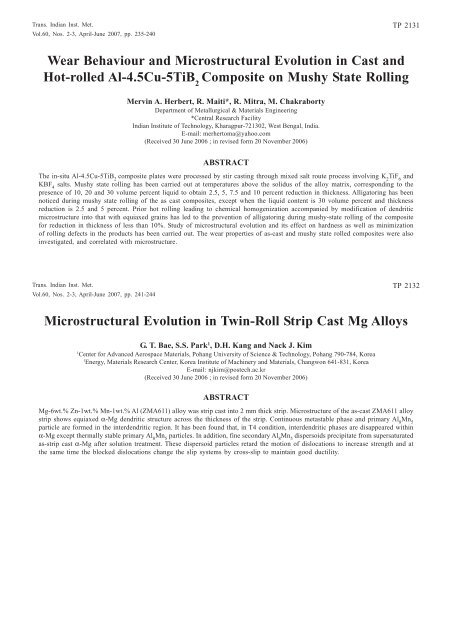Vol.60, Nos. 2-3 - Indira Gandhi Centre for Atomic Research
Vol.60, Nos. 2-3 - Indira Gandhi Centre for Atomic Research
Vol.60, Nos. 2-3 - Indira Gandhi Centre for Atomic Research
Create successful ePaper yourself
Turn your PDF publications into a flip-book with our unique Google optimized e-Paper software.
Trans. Indian Inst. Met.<br />
<strong>Vol.60</strong>, <strong>Nos</strong>. 2-3, April-June 2007, pp. 235-240<br />
TP 2131<br />
Wear Behaviour and Microstructural Evolution in Cast and<br />
Hot-rolled Al-4.5Cu-5TiB 2<br />
Composite on Mushy State Rolling<br />
Mervin A. Herbert, R. Maiti*, R. Mitra, M. Chakraborty<br />
Department of Metallurgical & Materials Engineering<br />
*Central <strong>Research</strong> Facility<br />
Indian Institute of Technology, Kharagpur-721302, West Bengal, India.<br />
E-mail: merhertoma@yahoo.com<br />
(Received 30 June 2006 ; in revised <strong>for</strong>m 20 November 2006)<br />
ABSTRACT<br />
The in-situ Al-4.5Cu-5TiB 2<br />
composite plates were processed by stir casting through mixed salt route process involving K 2<br />
TiF 6<br />
and<br />
KBF 4<br />
salts. Mushy state rolling has been carried out at temperatures above the solidus of the alloy matrix, corresponding to the<br />
presence of 10, 20 and 30 volume percent liquid to obtain 2.5, 5, 7.5 and 10 percent reduction in thickness. Alligatoring has been<br />
noticed during mushy state rolling of the as cast composites, except when the liquid content is 30 volume percent and thickness<br />
reduction is 2.5 and 5 percent. Prior hot rolling leading to chemical homogenization accompanied by modification of dendritic<br />
microstructure into that with equiaxed grains has led to the prevention of alligatoring during mushy-state rolling of the composite<br />
<strong>for</strong> reduction in thickness of less than 10%. Study of microstructural evolution and its effect on hardness as well as minimization<br />
of rolling defects in the products has been carried out. The wear properties of as-cast and mushy state rolled composites were also<br />
investigated, and correlated with microstructure.<br />
Trans. Indian Inst. Met.<br />
<strong>Vol.60</strong>, <strong>Nos</strong>. 2-3, April-June 2007, pp. 241-244<br />
TP 2132<br />
Microstructural Evolution in Twin-Roll Strip Cast Mg Alloys<br />
G. T. Bae, S.S. Park 1 , D.H. Kang and Nack J. Kim<br />
1<br />
Center <strong>for</strong> Advanced Aerospace Materials, Pohang University of Science & Technology, Pohang 790-784, Korea<br />
1<br />
Energy, Materials <strong>Research</strong> Center, Korea Institute of Machinery and Materials, Changwon 641-831, Korea<br />
E-mail: njkim@postech.ac.kr<br />
(Received 30 June 2006 ; in revised <strong>for</strong>m 20 November 2006)<br />
ABSTRACT<br />
Mg-6wt.% Zn-1wt.% Mn-1wt.% Al (ZMA611) alloy was strip cast into 2 mm thick strip. Microstructure of the as-cast ZMA611 alloy<br />
strip shows equiaxed -Mg dendritic structure across the thickness of the strip. Continuous metastable phase and primary Al 8<br />
Mn 5<br />
particle are <strong>for</strong>med in the interdendritic region. It has been found that, in T4 condition, interdendritic phases are disappeared within<br />
-Mg except thermally stable primary Al 8<br />
Mn 5<br />
particles. In addition, fine secondary Al 8<br />
Mn 5<br />
dispersoids precipitate from supersaturated<br />
as-strip cast -Mg after solution treatment. These dispersoid particles retard the motion of dislocations to increase strength and at<br />
the same time the blocked dislocations change the slip systems by cross-slip to maintain good ductility.
















